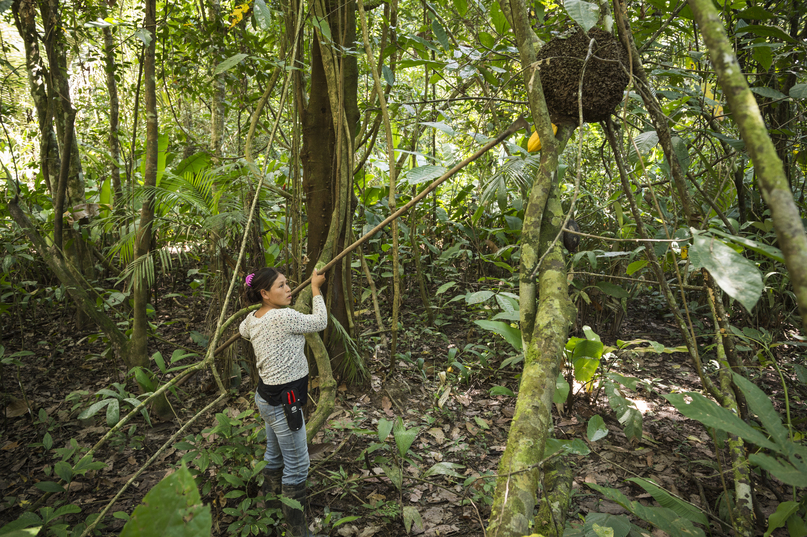Non-timber forest products can increase viability of sustainable forestry, says new study
21 June 2021, Yokohama, Zurich

A local woman harvests wild cocoa in the Bolivian Amazon. Photo: S. Opladen/Helvetas
Integrating non-timber forest products such as nuts, fruits, latex and rattan into the management of natural tropical timber production forests could be an important step towards economically viable sustainable forest management, according to a report released today by ITTO and the Precious Forests Foundation.
“For centuries, forest-dependent peoples have known and used numerous nuts, fruits and other plant and animal products for food and medicine—what today we call non-timber forest products, or NTFPs,” said Jürgen Blaser, the lead author of the report. “But modern forestry has paid scant attention to them, which is an opportunity lost to earn additional income from natural forests and thereby increase the economic viability of sustainable forestry.”
The new study, published as Not Only Timber, takes a close look at various NTFPs, the management of which could be compatible with timber production and other forest uses and would help local communities improve their livelihoods.
The report, which draws on the authors’ field experience and a thorough review of the literature, explores multiple-use forest management approaches in which NTFPs help make the economic case for natural forests. It describes how these NTFPs can be grown and harvested in tropical production forests while respecting traditional forest-community interests and rights. It presents three examples of well-established NTFPs in humid tropical forests—Brazil nut, rattan and rubber. For each, it examines the factors and strategies that have enabled the sustainable harvesting of the NTFP, as well as the challenges involved in maintaining a sustainable NTFP management regime.
The report also describes six promising NTFPs that grow in tropical forests—two each from tropical Africa, Southeast Asia and the Amazon—for which the potential is yet to be fully realized. And it uses a five-star system to rate the potential of 28 individual NTFPs to yield positive economic, social and environmental outcomes.
The report found that, for many NTFPs, good-quality, up-to-date information is lacking on production volumes and prices, including for some major NTFPs, and this is hindering development.
“There is an urgent need for more market studies on promising NTFPs,” said Dr Blaser. “Coordinated marketing campaigns will also be important for establishing lucrative markets for NTFPs.”
The aim of a follow-up study, commissioned by Precious Forests Foundation, is to identify tangible sustainable business development opportunities and hurdles for NTFPs.
“Natural forests remain under threat worldwide and especially in the tropics,” said Dr Blaser. “We should leave no stone unturned to generate income from sustainably managed natural forests, especially for local people, because that will help conserve those forests. Non-timber forest products can be an important part of the economic mix.”
The report is available at www.itto.int/technical_report/ and https://precious-forests.foundation/en/news/.
The International Tropical Timber Organization (ITTO) is an intergovernmental organization promoting the conservation and sustainable management, use and trade of tropical forest resources. It develops internationally agreed policy documents to promote sustainable forest management and forest conservation; assists tropical member countries to adapt such policies to local circumstances and to implement them in the field through projects; collects, analyzes and disseminates data on the production and trade of tropical timber; and funds actions aimed at developing sustainable forest industries at the community and industrial scales.
The Precious Forests Foundation is dedicated to improving the sustainable use and valorization of tropical forests, thus contributing to the lasting preservation of their ecosystem services for both local communities and the planet and to the responsible multiple use of their renewable wood and non-wood products. The foundation promotes and finances innovations based on applied research relevant to the practice of certified sustainable forest management.


